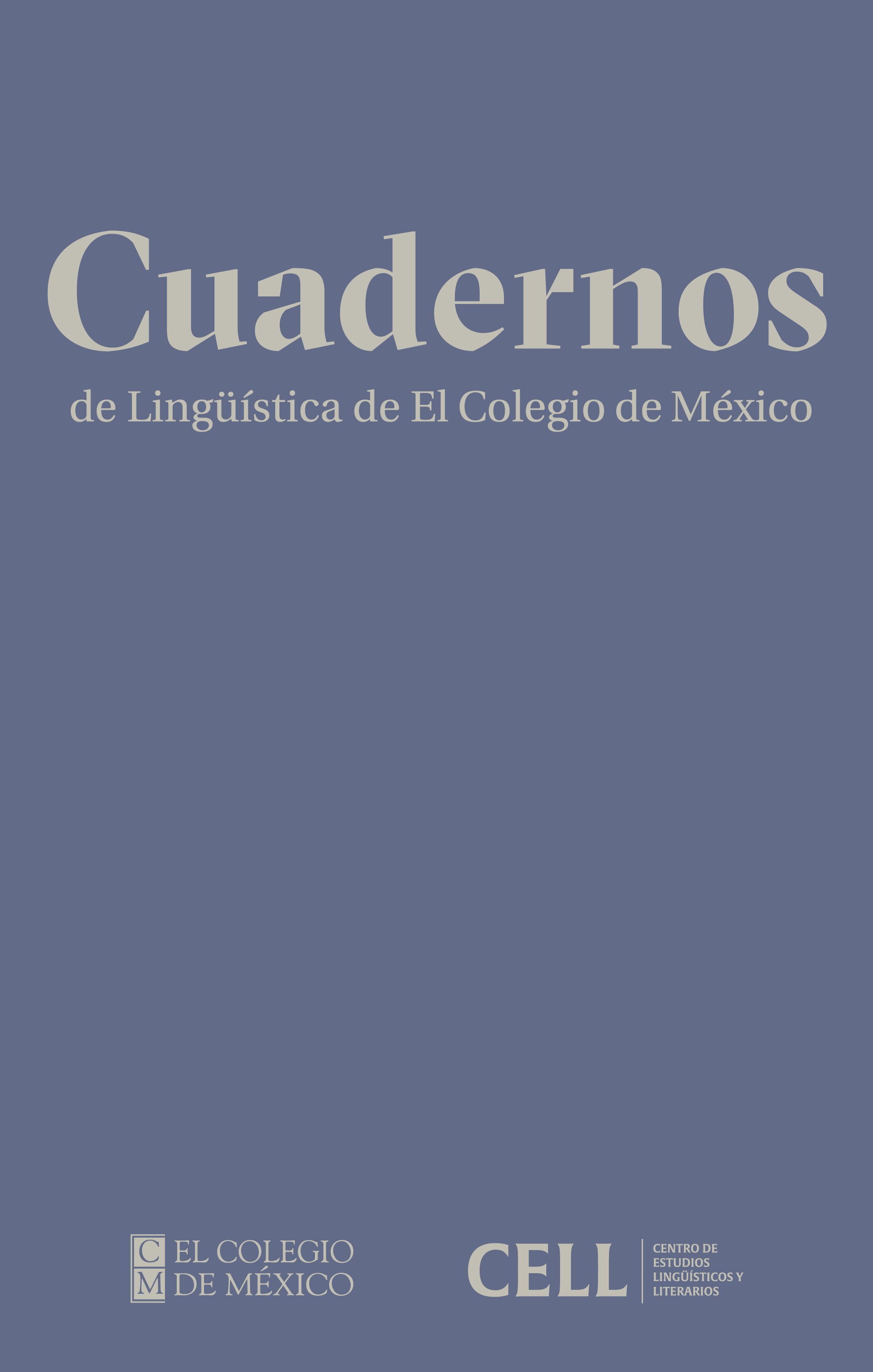Exploration of grammatical roles in San Felipe Santiago Otomi from corpus data
DOI:
https://doi.org/10.24201/clecm.v9i0.222Keywords:
Oto-Manguean, Oto-Pamean, morphosyntax, animacy, linguistic typologyAbstract
This paper explores the coding of arguments in San Felipe Santiago Otomi (Oto-Manguean > Oto-Pamean), or Ñätho, in data gathered from an oral
corpus consisting of 1 hour of recordings, as well as from a written corpus consisting of a New Testament translation. By using nine different criteria (word order, person-marking in the verb, number marking in the verb, antipassive construction, middle construction, relativization, wh- interrogation, causative construction, and zero anaphora), it is shown that the coding of arguments seems to obey participant animacy rather than thematic roles by themselves. The data presented are also discussed under the government and binding approach, as well as a typological approach.
Downloads
References
Allerton, D. J. 1978. The notion of “givenness” and its relation with presupposition and to theme. Lingua 44. 133–168. DOI: https://doi.org/10.1016/S0024-3841(20)30063-2
Andrews, Henrietta. 1993. The function of verb prefixes in Southwestern Otomi. Arlington: Instituto Lingüístico de Verano-Universidad de Texas en Arlington.
Bartholomew, Doris A. 2010. Notas sobre la gramática del hñähñu (otomí). En L. Hernández, M. Victoria, & D. Sinclair, Diccionario del hñähñu (otomí) del Valle del Mezquital, estado de Hidalgo, 497–516. México DF: Instituto Lingüístico de Verano.
Bickel, Balthasar. 2010. Grammatical relations typology. En J. J. Song, The Oxford handbook of linguistic typology, 399–444. Oxford: Oxford University Press. DOI: https://doi.org/10.1093/oxfordhb/9780199281251.013.0020
Bisang, W. 2006. From meaning to syntax - semantic roles and beyond. En Bornkessel, I.; Schlesewsky, M.; Comrie, B. & Friederici, A. D., Semantic role universals and argument linking. Theoretical, typological, and psycholinguistic perspectives, 191–236. Berlín: Mouton de Gruyter.
Carnie, A. 2013. Syntax: A generative introduction. Chichester, RU: Wiley-Blackwell.
Citko, Barbara. 2004. On headed, headless, and light-headed relatives. Natural Language & Linguistic Theory 22. 95–126. DOI: https://doi.org/10.1023/B:NALA.0000005564.33961.e0
Croft, William. 2003. Typology and universals (2 ed.). Cambridge: Cambridge University Press.
Dryer, Matthew S. 1986. Primary objects, secondary objects, and antidative. Language 62(4). 808–845. DOI: https://doi.org/10.2307/415173
Ecker, Lawrence. 2012(1952). Compendio de gramática otomí. En Y. Lastra, & D. A. Bartholomew, Diccionario etimológico del otomí colonial y compendio de gramática otomí,. 21–41. México: UNAM-Instituto de Investigaciones Antropológicas. DOI: https://doi.org/10.22201/iia.9786070232275p.2012
Givón, Talmy. 2001. Syntax: An introduction. Ámsterdam: John Benjamins. DOI: https://doi.org/10.1075/z.syn1
Haspelmath, Martin. (2005). Argument marking in ditransitive alignment types. Linguistic Discovery 3(1). 1–21. DOI: https://doi.org/10.1349/PS1.1537-0852.A.280
Hernández Gómez, María de Jesús Selene. (2008). Marcación verbal de objeto y de dativo en el otomí de San Ildefonso Tultepec. Querétaro: Universidad Autónoma de Querétaro. (Tesis de maestría.)
Hernández-Green, Néstor. (2016a). Alineamiento semántico y lexicalización en el sistema de marcación de sujeto en otomí-mazahua. Signos Lingüísticos, XII(24). 36–67.
Hernández-Green, Néstor. (2016b). Registration versus applicative constructions in Acazulco Otomi. International Journal of American Linguistics, 82(3). 353–383. DOI: https://doi.org/10.1086/687386
Hernández-Green, Néstor. 2020. Alineamiento morfosintáctico del hñähñú (otomí del Valle del Mezquital). Alfa 64. 1–31. DOI: https://doi.org/10.1590/1981-5794-e11816
Hernández-Green, Néstor, & Álvarez Gabino, Eonice. 2020. Pasado y presente de la lengua otomí en San Felipe Santiago, Jiquipilco (Estado de México). Icha Tecolotl. (Obtenido de https://ichan.ciesas.edu.mx/mur-mbaxjua-ka-ga%cc%a0tho-ndar-manga%cc%a0he-ra-hnatho-bu%cc%a01-pasado-y-presente-de-la-lengua-otomi-en-san-felipe-santiago-jiquipilco-estado-de-mexico/)
INALI. 2014. Njaua nt'ot'i ra hñähñu. Norma de escritura de la lengua hñähñu (otomí). México: Instituto Nacional de Lenguas Indígenas.
INEGI. 2010. Censo de población y vivienda 2010. Ciudad de México: INEGI. (Obtenido de https://www.inegi.org.mx/programas/ccpv/2010/#Microdatos)
Keenan, Edward. 1976. Towards a universal definition of ‘subject’. En C. N. Li, Subject and topic, 305–333. Nueva York: Academic Press.
Lastra, Yolanda. 1998. El número en los dialectos otomíes. Boletín de Filología de la Universidad de Chile, XXXVII. 645–658.
LBI. (2010). El Nuevo Testamento en el otomí del estado de México. Liga Bíblica Internacional.
Palancar, Enrique L. 2004. Datividad en otomí. Estudios de Cultura Otopame 4. 171–196.
Palancar, Enrique L. 2006. Intransitivity and the origins of middle voice in Otomi. Linguistics 44(3). 613–643. DOI: https://doi.org/10.1515/LING.2006.020
Palancar, Enrique L. 2008. The emergence of active/stative alignment in Otomi. En M. Donohue, & S. Wichmann, The typology of semantic alignment (págs. 357–379). Oxford: Oxford University Press. DOI: https://doi.org/10.1093/acprof:oso/9780199238385.003.0014
Palancar, Enrique L. 2009. Gramática y textos del hñöñhö: Otomí de San Ildefonso Tultepec, Querétaro. México DF: Plaza y Valdés.
Palancar, Enrique L. 2013. The evolution of number in Otomi: The many faces of the dual. Studies in Language 37(1). 94–142. DOI: https://doi.org/10.1075/sl.37.1.03pal
Wallis, Ethel E. 1964. Mezquital Otomi verb fusion. Language 40(1). 75–82. DOI: https://doi.org/10.2307/411926
Witzlack, Alena. 2010. Typological variation in grammatical relations. Leipzig: Universidad de Leipzig. (Tesis doctoral.)
Published
How to Cite
-
Abstract828
-
PDF (Español)248
-
XML (Español)11
-
EPUB (Español)31
-
Kindle (Español)72
-
MP3 (Español)11
Issue
Section
License
Copyright (c) 2022 Néstor Hernández-Green

This work is licensed under a Creative Commons Attribution-NonCommercial-NoDerivatives 4.0 International License.
Authors retain copyright of their work and are free to disseminate it, make copies for any use, and/or deposit in any repository or archive of their choice, but they grant Cuadernos de Lingüística de El Colegio de México the right to publish the work for the first time. Authors agree to acknowledge Cuadernos de Lingüística de El Colegio de México as the site of original publication of their article / note / review through proper citation.
Articles appearing in Cuadernos de Lingüística de El Colegio de México are made available to readers under a Attribution-NonCommercial-NoDerivatives 4.0 International.









